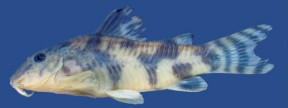Scleromystax salmacis
Etymology
Scleromystax: from the Ancient Greek σκληρός (sklērós), meaning ‘hard’, and μύσταξ (mústaks), meaning ‘upper lip’.
salmacis: “named after the character of Ovid’s tale, “The fountain of Salmacis”. From the Greek Salmacis, a nymph who had fallen in love with Hermaphroditus, the son of Hermes and Aphrodite. To avoid letting him go, Salmacis leapt upon him, and they both tumbled into the waters of her fountain, legs and arms twisted around each other. Filled with despair, the nymph shouted to the heavens, imploring the Fates or the gods
never to allow the two of them to be separated. From her strength of will and his divine heritage, between the thrashing of the pure water and the twisting of limbs, the two merged into one form. It had one pair of arms, one set of legs, one head and one face but was both male and female at the same time. So Hermaphroditus, who was both male and female in name, cursed the pool for making him the same in body. To this day men hesitate to drink or bathe in waters taken from the fountain of Salmacis in fear that a similar fate shall befall them as well. In allusion to its very subtle sexual dimorphism when compared to other Scleromystax species.”
Classification
Order: Siluriformes Family: Callichthyidae
Distribution
Known only from the rios Mampituba and Araranguá, both coastal river systems in the state of Santa Catarina, southern Brazil.
Type locality is ‘Arroio Molha Coco in Rosa, nearly 5.5 kilometers northwest of Praia Grande, 29°10’14″S, 49°58’53″W, Praia Grande, Santa Catarina State, Brazil’.
Habitat
In March 2002 the type locality comprised a small pool with slowly-moving, clear water, and a rocky substrate covered with a thin layer of mud. Vegetation consisted of riparian grasses with shade provided by low trees and bamboo shrubs. The pool was maintained by a small creek with periodic flooding events due to the its proximity to a larger stream.
Sympatric fish species included Steindachnerina biornata, Mimagoniates rheocharis, Astyanax scabripinnis, Hollandichthys sp., Rineloricaria aequalicuspis, Pareiorhaphis nudula, and Phalloceros caudimaculatus.
In contrast, a habitat in the rio Ratones drainage comprised an open, sandy bank.
Maximum Standard Length
The largest specimen known to date measured 48.2 mm.
Diet
Scleromystax spp. are foraging omnivores, and most will accept sinking dried foods as well as small live and frozen varieties such as chironomid larvae (bloodworm), Tubifex, etc. Feeding a varied diet will ensure the fish are in optimum condition.
Under no circumstances should they be expected to survive on ‘left-overs’ from other inhabitants of the aquarium or relied on to ‘clean’ the aquarium.
NotesTop ↑
This species can be distinguished from congeners by the following combination of characters: presence of only one perforated dorsolateral body plate (vs. none or 2-5 perforated dorsolateral body plates); ventral keel of scapulocoracoid orientated towards anterior margin of bone, its anterior portion surpassing horizontal through middle of mesial border of scapulocoracoid (vs. keel parallel to posterior margin of the
scapulocoracoid, not surpassing horizontal through middle of mesial border of bone); preopercular-opercular region similar in males and females, with only minute, scattered odontodes (vs. males with developed odontodes inserted in fleshy papillae); and dorsal and pectoral fins equal in length on both sexes (vs. dorsal and pectoral fins of males 2-3 times as long as those fins in females).
It is most similar to S. macropterus, but differs in absence (vs. presence) of a black spot on the base of the median caudal-fin rays, a higher number of pectoral-fin rays (I,8,i vs. I,7,i), males with somewhat more slender bodies (25.7- 30.5% in SL [range 26.3-28.8% in type series] vs. 30.4-34.6% in SL), and possession of more irregular transverse blotches along the body.
The genus Scleromystax is included in the family Callichthyidae, of which members are often referred to collectively as ‘armoured’ or ‘mailed’ catfishes group due to the presence of bony plates in place of scales on the body.
Their taxonomy is confusing, and numerous undescribed species are also thought to exist. Fish of unconfirmed identification entering the aquarium hobby are therefore typically assigned a ‘C’ or ‘CW’ number for purposes of reference and organisation.
They are facultative air breathers and possess a modified, highly vascularised intestine which has evolved to facilitate uptake of atmospheric oxygen and aid survival in oxygen-deprived environments. In the aquarium you’ll occasionally see them rising to the surface to take in gulps of air.
The stiffened pectoral-fin spines are capable of piercing human skin and a ‘sting’ can be very painful indeed, so care should be exercised when handling them. It is thought that secretions from the axillary glands at the base of each spine may even be mildly toxic or venomous.
References
- Britto, M. R. and R. E. Reis, 2005 - Neotropical Ichthyology 3(4): 481-488
A new Scleromystax species (Siluriformes: Callichthyidae) from coastal rivers of southern Brazil. - Ferraris, C. J., Jr., 2007 - Zootaxa 1418: 1-628
Checklist of catfishes, recent and fossil (Osteichthyes: Siluriformes), and catalogue of siluriform primary types.





